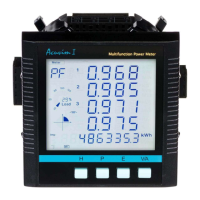10
Considerations When Installing Meters
Installation of the meter must be performed by qualied personnel only, who
follow standard safety precautions through the installation procedures. Those
personnel should have appropriate training and experience with high voltage
devices. Appropriate safety gloves, safety glasses and protective clothing are
recommended.
During normal operation, dangerous voltage may ow through many parts of
the meter, including terminals, and any connected CTs (Current Transformers)
and PTs (Potential Transformers), all I/O (Inputs and Outputs) modules and their
circuits. All primary and secondary circuits can, at times, produce lethal voltages
and currents. AVOID contact with any current-carrying surfaces.
The meter and its I/O output channels are NOT designed as primary protection
devices and shall NOT be used as primary circuit protection or in an energy-
limiting capacity. The meter and its I/O output channels can only be used as
secondary protection. AVOID using the meter under situations where failure of
the meter may cause injury or death. AVOID using the meter for any application
where risk of re may occur.
All meter terminals should be inaccessible after installation.
Do NOT perform Dielectric (HIPOT) test to any inputs, outputs or communication
terminals. High voltage testing may damage electronic components of the meter.
Applying more than the maximum voltage the meter and/or its modules can
withstand will permanently damage the meter and/or its modules. Please refer
to the specications for all devices before applying voltages.

